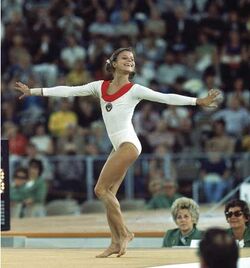Olga Valentinovna Korbut (Belarusian: Вольга Валянцінаўна Корбут, Volha Valancinaŭna Korbut; Russian: Ольга Валентиновна Корбут) (b. May 16, 1955 in Hrodna), also known as the Sparrow from Minsk, is a Belarusian, Soviet-born gymnast who won four gold medals and two silver medals at the Summer Olympics, in which she competed in 1972 and 1976 for the USSR team. Unarguably one of the most famous and influential gymnasts of all time, Korbut's displays of innovative skills, waifish athleticism and charisma captivated audiences and also marked the beginning of a change in Women's Artistic Gymnastics, one that saw the trend shift from mature women performing basic work that emphasized elegance to young girls performing highly difficult and complex acrobatics.
Early Life[]
Korbut, who started training at age 8, entered a Belarusian sports school headed by coach Renald Knysh at age 11. There, Korbut's first trainer was Elena Volchetskaya (an Olympian), but she was moved to Knysh's group a year later. With him, she learned a difficult backward somersault on the balance beam. She debuted this at a competition in the USSR in 1969. Also, in 1969, Olga completed a backflip-to-catch on the uneven bars. This was the first backward release move ever performed by a woman on bars.
She ended fifth at her first competition in the 1969 USSR championships. The next year, she won a gold medal in the vault. Due to illness and injury, she was unable to compete in many of the tournaments prior to the 1972 Olympics.
Olympics[]
At the 1972 Olympics, her acrobatics and open display of emotion—notably, she wiped tears from her face after a disastrous uneven bars routine—in contrast to the stereotypically cold eastern bloc athlete, captivated the Munich audiences. There she became one of the first persons ever to do a backward somersault on the balance beam in competition. She was also the first to do a standing backward somersault on bars, and a back somersault to swingdown (Korbut Flip) on beam. Her bars move is no longer seen in high level gymnastics, but the tuck back and Korbut Flip are still very popular (2003 world beam champion Fan Ye performed both in her routine). This excellence in technical skills overthrew the sport's traditional emphasis on artistry.
During the Olympics, Korbut was one of the favourites for the all-around after her dynamic performance in the team competition; however, she missed her mount on bars three times and the title went to her teammate Ludmilla Tourischeva. Notwithstanding, Korbut won three gold medals for the balance beam, floor exercise and team. In one of the most controversial finishes of all time, she took a silver medal in the uneven bars. Korbut's first attempt at her uneven bars routine was marred by several mistakes which all but ended her chances of winning a gold medal in the all around. The next day, Korbut repeated the same routine in the event finals, although this time successfully. After the boards displayed a score of 9.8, the audience began to whistle, jeer, stamp their feet, and shout vulgar remarks at the judges in disapproval, believing her score to be too low. This carried on for several minutes, however, the judges refused to change her score. A similar display of audience disapproval occurred thirty-two years later at the 2004 Athens Olympics, this time involving Russian gymnast Alexei Nemov's score; however, after 15 minutes of audience protest his score was slightly adjusted.
Korbut is most famous for her uneven bars and balance beam routines. Her Olympic achievement earned her ABC's Wide World of Sports title: Athlete of the Year. In 1973, she won the Russian and World Student (i.e., University) Games, and a silver medal in the all-around at the European Championships.
The Soviet coaches and officials had designated Olga as the woman who could beat the Romanian prodigy, Nadia Comăneci, in the 1976 Summer Olympics at Montreal, but Olga was injured and her performances in the games were under-par. She was overshadowed not only by Comaneci, but also by her own teammate Nellie Kim. She did collect a team gold medal, and an individual silver medal for the balance beam.
Medal Count[]
| Year | Event | TF | AA | VT | UB | BB | FX |
|---|---|---|---|---|---|---|---|
| 1969 | USSR Championships | 5 | |||||
| 1970 | USSR Championships | 1st | |||||
| Chunichi Cup | 2nd | ||||||
| USSR Cup | 1st | 2nd | |||||
| 1971 | Chunichi Cup | 3rd | |||||
| USSR Championships | 1st | 5 | 2nd | ||||
| 1972 | Munich Olympic Games | 1st | 7 | 5 | 2nd | 1st | 1st |
| USSR Cup | 1st | 2nd | 2nd | ||||
| USSR Championships | 2nd | 3rd | 2nd | 2nd | |||
| Riga International | 1st | 1st | 1st | 1st | 1st | ||
| 1973 | London European Championships | 2nd | |||||
| USSR Championships | 1st | ||||||
| Moscow Summer Universiade | 1st | 1st | 3rd | 1st | 1st | 1st | |
| 1974 | Varna World Championships | 1st | 2nd | 1st | 2nd | 2nd | 2nd |
| USSR Cup | 2nd | 1st | 1st | ||||
| USSR Championships | 4 | 2nd | 1st | 1st | |||
| 1975 | London World Cup Final | 2nd | |||||
| USSR Championships | 1st | 1st | 2nd | 6 | 1st | 5 | |
| 1976 | Montreal Olympic Games | 1st | 5 | 5 | 2nd | ||
| USSR Cup | 3rd | 2nd | 1st |

